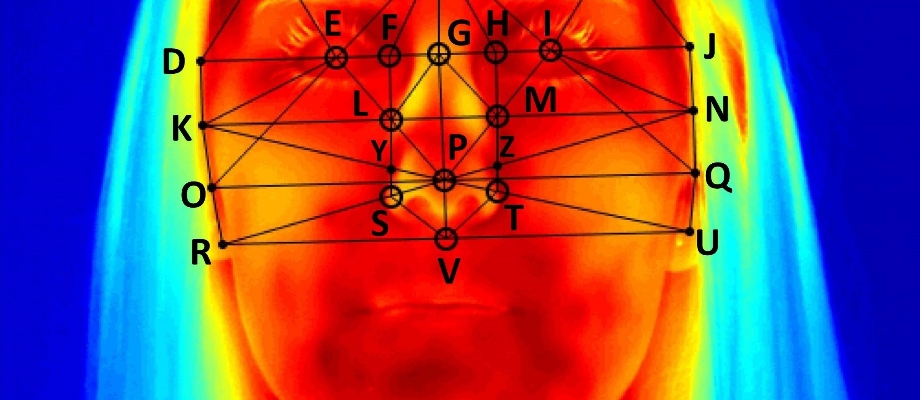
How the temperature of your nose shows how much strain you are under
January 19th, 2018
Researchers at the University of Nottingham’s Institute for Aerospace Technology (IAT), together with academic staff from the Bioengineering and Human Factors Research Groups, have demonstrated that facial temperatures, which can be easily measured using a non-invasive thermal camera, are strongly correlated to mental workload.
It was found that the effect is most pronounced above the sinuses around the nose, and that facial temperatures were reduced as participants carried out tasks of increasing difficulty.
The results show that when people are fully focused on a task, their breathing rate changes as the autonomic nervous system takes over. There may also be a diversion of blood flow from the face to the cerebral cortex as the mental demand increases, although this is the subject of further research.
Non-invasive, non-obtrusive monitoring of cognitive workload is of vital importance in fields where excessive cognitive demands on an operator can contribute to oversights and use errors – particularly when these errors can have tragic results. This study, published in Human Factors, explores how advances in performance and resolution in thermal cameras have made this a reality.
Recent advances in digital thermography have made the cameras used light enough and small enough to be placed in an aircraft’s cockpit. In addition, improvements in resolution and computing power will allow the implementation of expert systems which can be programmed to recognise the operator and how he or she will react to varying mental demands.
Adrian Marinescu, a Marie Skłodowska-Curie Early Stage Researcher who has been examining physiological responses to workload in his PhD in aerospace human factors, and the first author of the paper, said: “The preliminary results are promising. Our goal is to estimate workload using non-invasive and non-intrusive physiological monitoring. Of all the approaches we’ve tried, facial thermography is the least intrusive, and has proved to be an excellent method – it’s convenient, gives real-time data, and the cameras have been getting smaller, lighter and more affordable.”
Professor Sarah Sharples, Professor of Human Factors, and supervisor and initiator of the study, said: “The measurement of workload without needing to interrupt people to ask them to report how busy they are, has been challenging human factors specialists for many years. By bringing together our expertise in bioengineering, human factors and machine learning, we have developed a much better understanding of how physical changes associated with workloads manifest themselves as physiological symptoms, and how these symptoms translate into the parameters that we can measure.”
Dr Alastair Campbell Ritchie of the Bioengineering Research Group, said: “We expected that mental demands on an operator would result in physiological changes, but the direct correlation between the workload and the skin temperature was very impressive, and counter-intuitive – we were not expecting to see the face getting colder. With this accurate way to estimate workload, we can develop methods that will assist the operator at times of maximum stress.”
The project formed part of a larger European Union funded, Marie Curie Actions Initial Training Network (ITN) called InNovAte (the systematic Integration of Novel Aerospace Technologies), Grant agreement number 608322. This human factors project benefitted from a University-industry partnership with Airbus.
Professor Herve Morvan, Director of the IAT said: “InNovAte has seen tremendous success in combining the various strands of aerospace research and enabling our ESRs to take a more holistic approach to aircraft design and operation. Pilot fatigue has received greater exposure recently and developing an advanced system to monitor it is a significant step in a sector where safety is paramount.”
The researchers are continuing this study to allow for the broader application of the monitoring to further enhance the accuracy of workload estimation. Research continues into the estimation of operator workload in fine manual tasks requiring acute concentration as well as mental workload in situations requiring temporal and spatial awareness.
Tags: Bioengineering research group, digital thermography, human factors, Human Factors research group, IAT, INNOVATE, Institute for Aerospace Technology, mental health, stress
4 Comments
Other

Need news? See you on SharePoint
After 14 years of service, Campus News is being retired as the university’s staff news platform. […]

Roads and car parks closed for refurbishing work
As part of ongoing road improvements at the university, works will be taking place to resurface […]


January 23rd, 2018 at 7:55 pm
MP
It would be interesting to observe the thermal images of those who are having seizures to see how that brain activity affects facial temperatures.
Both my aunt and I have migraines with seizures and both of us experience a severely cold nose leading up to and during these. When I tell my neurologist, he just tilts his head curiously and can’t imagine the connection. This study seems to perhaps offer one, should further studies be carried out with the aforementioned focus.
Anyway, great work and good to know.
January 24th, 2018 at 10:30 am
KH
Nice work.
It would also be interesting to see if this is linked to appearance of cold sores through virus activation. I get sores on my nose primarily, and the first tingling feeling prior to them being visible correlates to stress and cold weather. I don’t know if there is a model for the viral infection that could be thermally imaged.
January 24th, 2018 at 11:18 am
toni
Hi This is really interesting research
My friend always gets a really cold nose just before she gets an intestinal cramp attack and is then often sick; It usually occurs when she has been under a lot of pressure and I have always said it is probably the stress.
This research seems to indicate this is the case.
regards
Toni
January 24th, 2018 at 11:22 am
Seoh
My nose get cold frequently. I even wake up with cold nose. Does that mean I am under stress while sleeping? Have great deal of pain issues — awake and sleeping.